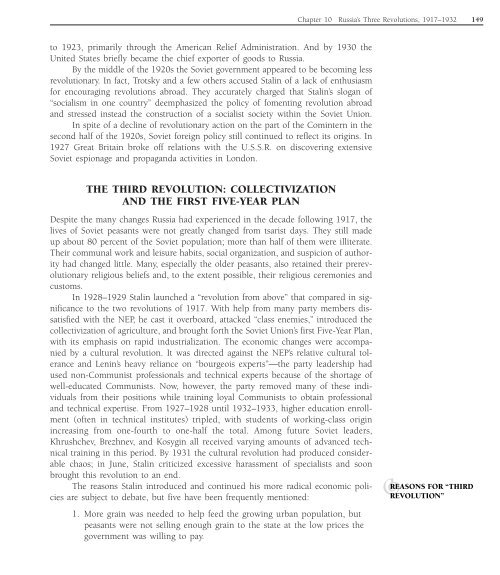Russia's Three Revolutions, 1917–1932
Russia's Three Revolutions, 1917–1932
Russia's Three Revolutions, 1917–1932
Create successful ePaper yourself
Turn your PDF publications into a flip-book with our unique Google optimized e-Paper software.
Chapter 10 Russia’s <strong>Three</strong> <strong>Revolutions</strong>, <strong>1917–1932</strong> 149to 1923, primarily through the American Relief Administration. And by 1930 theUnited States briefly became the chief exporter of goods to Russia.By the middle of the 1920s the Soviet government appeared to be becoming lessrevolutionary. In fact, Trotsky and a few others accused Stalin of a lack of enthusiasmfor encouraging revolutions abroad. They accurately charged that Stalin’s slogan of“socialism in one country” deemphasized the policy of fomenting revolution abroadand stressed instead the construction of a socialist society within the Soviet Union.In spite of a decline of revolutionary action on the part of the Comintern in thesecond half of the 1920s, Soviet foreign policy still continued to reflect its origins. In1927 Great Britain broke off relations with the U.S.S.R. on discovering extensiveSoviet espionage and propaganda activities in London.THE THIRD REVOLUTION: COLLECTIVIZATIONAND THE FIRST FIVE-YEAR PLANDespite the many changes Russia had experienced in the decade following 1917, thelives of Soviet peasants were not greatly changed from tsarist days. They still madeup about 80 percent of the Soviet population; more than half of them were illiterate.Their communal work and leisure habits, social organization, and suspicion of authorityhad changed little. Many, especially the older peasants, also retained their prerevolutionaryreligious beliefs and, to the extent possible, their religious ceremonies andcustoms.In 1928–1929 Stalin launched a “revolution from above” that compared in significanceto the two revolutions of 1917. With help from many party members dissatisfiedwith the NEP, he cast it overboard, attacked “class enemies,” introduced thecollectivization of agriculture, and brought forth the Soviet Union’s first Five-Year Plan,with its emphasis on rapid industrialization. The economic changes were accompaniedby a cultural revolution. It was directed against the NEP’s relative cultural toleranceand Lenin’s heavy reliance on “bourgeois experts”—the party leadership hadused non-Communist professionals and technical experts because of the shortage ofwell-educated Communists. Now, however, the party removed many of these individualsfrom their positions while training loyal Communists to obtain professionaland technical expertise. From 1927–1928 until 1932–1933, higher education enrollment(often in technical institutes) tripled, with students of working-class originincreasing from one-fourth to one-half the total. Among future Soviet leaders,Khrushchev, Brezhnev, and Kosygin all received varying amounts of advanced technicaltraining in this period. By 1931 the cultural revolution had produced considerablechaos; in June, Stalin criticized excessive harassment of specialists and soonbrought this revolution to an end.The reasons Stalin introduced and continued his more radical economic policiesare subject to debate, but five have been frequently mentioned:1. More grain was needed to help feed the growing urban population, butpeasants were not selling enough grain to the state at the low prices thegovernment was willing to pay.REASONS FOR “THIRDREVOLUTION”




